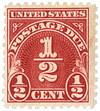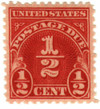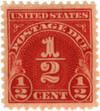
# J69 - 1930 ½c Postage Due Stamp - carmine
Postage Due Stamps
On March 3, 1879, an Act of Congress authorized the use of Postage Due stamps. These stamps were unique, since they were the first US stamps that didn’t prepay for the delivery of mail. Instead, they denoted the amount of postage to be collected by the person receiving the mail because it was insufficiently prepaid. In 1855, prepayment of postage was made mandatory. If letters didn’t have sufficient postage, postal clerks would hand write the amount due on the envelope. There was no accountability for greedy clerks who would collect more than was due and pocket the difference. The solution to the problem was Postage Due stamps. Each postmaster had to balance his books between the value of the Postage Due stamps used and the money collected. The first issues were printed by the American Bank Note Company and were released on July 1, 1879. Unlike regular postage stamps that paid for the delivery of mail, they denoted the amount of postage due on mail that was insufficiently prepaid. This amount was paid not by the sender, but rather by the recipient of the letter. Insufficient payment may have been because the letter was heavier than the sender realized, and they had not put enough postage on it to cover the extra weight. The stamps were also used on advertised letters or unpaid ship or steamboat letters. Designed solely for functional purposes, the stamps were plain with large numerals indicating the amount to be paid. For twenty-five years, this design remained unchanged – although the colors varied from a brown to red brown to a deep red. In 1894, the Bureau of Engraving and Printing (BEP) took over the contract for producing the Postage Due stamps, and the design changed slightly. While the early issues featured the numeral in an oval, these new releases had the value figure in a diamond. Additionally, while the first stamps were produced on unwatermarked paper, the following year they began using watermarked paper. In 1930, the BEP changed the designs so that the numerals were featured in a half-circle. The following year, the BEP changed the format of some of the stamps slightly – a horizontal format was used as opposed to the vertical one used previously. Stamps were also printed on the rotary press at this time. In 1959, the Postage Due stamps were printed in two colors for the first time. The designs of these issues were similar to the 1930-31 stamps. However, the border and background were printed in a carmine rose, while the numerals were printed in black. In addition to the color change, new values were also used. In 1985, full prepayment of postage was required, and Postage Due stamps were discontinued. Parcel Postage Due Effective January 1, 1913, the US Post Office offered parcel delivery. Parcel Postage Due stamps paid the makeup fee for underpaid packages. At the end of six months, the Parcel Posts (and Parcel Post Due stamps) were replaced with ordinary postage stamps. Click here for lots more Postage Dues, including single stamps and money-saving sets.Postage Due Stamps
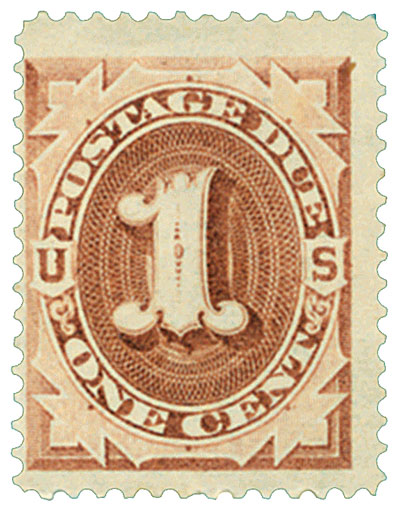

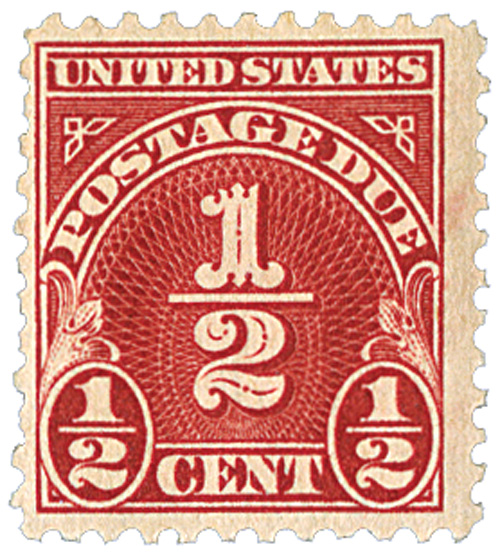
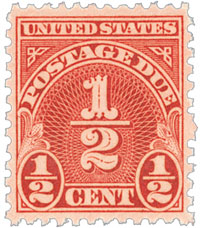
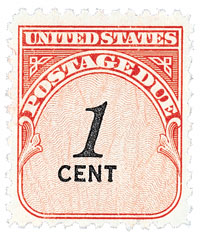
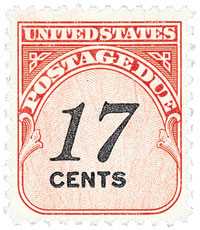
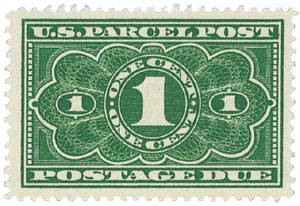
Postage Due Stamps
On March 3, 1879, an Act of Congress authorized the use of Postage Due stamps. These stamps were unique, since they were the first US stamps that didn’t prepay for the delivery of mail. Instead, they denoted the amount of postage to be collected by the person receiving the mail because it was insufficiently prepaid. In 1855, prepayment of postage was made mandatory. If letters didn’t have sufficient postage, postal clerks would hand write the amount due on the envelope. There was no accountability for greedy clerks who would collect more than was due and pocket the difference. The solution to the problem was Postage Due stamps. Each postmaster had to balance his books between the value of the Postage Due stamps used and the money collected. The first issues were printed by the American Bank Note Company and were released on July 1, 1879. Unlike regular postage stamps that paid for the delivery of mail, they denoted the amount of postage due on mail that was insufficiently prepaid. This amount was paid not by the sender, but rather by the recipient of the letter. Insufficient payment may have been because the letter was heavier than the sender realized, and they had not put enough postage on it to cover the extra weight. The stamps were also used on advertised letters or unpaid ship or steamboat letters. Designed solely for functional purposes, the stamps were plain with large numerals indicating the amount to be paid. For twenty-five years, this design remained unchanged – although the colors varied from a brown to red brown to a deep red. In 1894, the Bureau of Engraving and Printing (BEP) took over the contract for producing the Postage Due stamps, and the design changed slightly. While the early issues featured the numeral in an oval, these new releases had the value figure in a diamond. Additionally, while the first stamps were produced on unwatermarked paper, the following year they began using watermarked paper. In 1930, the BEP changed the designs so that the numerals were featured in a half-circle. The following year, the BEP changed the format of some of the stamps slightly – a horizontal format was used as opposed to the vertical one used previously. Stamps were also printed on the rotary press at this time. In 1959, the Postage Due stamps were printed in two colors for the first time. The designs of these issues were similar to the 1930-31 stamps. However, the border and background were printed in a carmine rose, while the numerals were printed in black. In addition to the color change, new values were also used. In 1985, full prepayment of postage was required, and Postage Due stamps were discontinued. Parcel Postage Due Effective January 1, 1913, the US Post Office offered parcel delivery. Parcel Postage Due stamps paid the makeup fee for underpaid packages. At the end of six months, the Parcel Posts (and Parcel Post Due stamps) were replaced with ordinary postage stamps. Click here for lots more Postage Dues, including single stamps and money-saving sets.Postage Due Stamps










